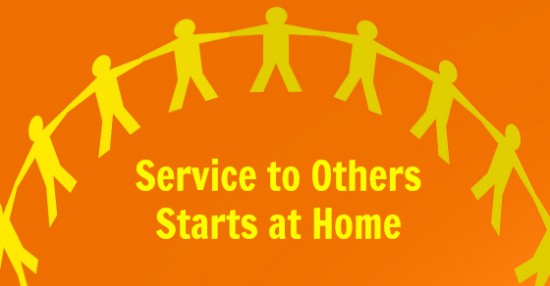“I’ll load my plate and cup into the dishwasher, but no one else’s!” my 11 year old says.
“I think after a day of school and volleyball practice, I should just get to do my homework and relax,” my teen says.
Both of these comments surprised and upset me. With no time to prepare, of course, as parents often wish they could, my initial response went something like this:
To my youngest: “No, you can put the other dishes away too. It’s part of being a family and helping each other out.”
To my eldest: “What if your dad or mom just sat around after their workdays? You would have no dinner or clean clothes. Can you imagine what our home would look like?”
Later, as I thought about their self-centered comments, I felt I was missing something bigger that they should be learning at home. It felt like the situation was more than leaving dishes in the sink and just watching television instead of folding laundry at the same time.
In both private and public schools now across our country, the focus on community service work is often part of the curriculum. It’s a good thing to show our children the value in giving their time to others. My daughters don’t complain about volunteering through school and organizations. They have fun with friends and feel good about their efforts. It’s often required and part of their class or membership.
As parents we can tell our children that their actions are not about a grade or a free ice cream cone, which is doing service for selfish reasons and only helps to increase our self-centered culture. I realized my daughters didn’t put together that helping their family and their community is service work for the love of neighbor, whether or not they earn an allowance.
As my 15 year old prepares for Confirmation this spring, she’s required to perform about a dozen service hours in a variety of sectors – including parish life. Each year, a student asks our pastor, “Why do we have to do service hours?”
His answer with a question surprised me, “What is the opposite of love?” Of course, everyone knows it’s “hate,” I thought to myself. “No, it’s not hate,” continues Monsignor Steve, as though reading my mind (and probably everyone’s.)
“It’s complacency, which is doing nothing,” he explains. “Love is a verb. It is an action word. Love is not a feeling.” Confirmation service hours offer students a fuller dimension of what it means to help their neighbor.
Yet service needs to start at home, when the children are younger than Confirmation age. They can learn through appropriate chores that they are helping to show love to their family. Again, love is action; it’s not a feeling. Feelings come and go. Love is constant.
As parents we intuitively know this, we always love our children, even when they disobey us. We discipline our children because we love them. Love is action. The opposite of love is complacency. The problem with complacency is it often leads to slothfulness, one of the seven deadly sins, which takes us further from God and His love.
We can help our children grow closer to God by having them do service work – out in the community and especially at home. With the holiday season quickly approaching, there will be plenty of opportunity for volunteering as a family, but keep love in action all year long.
Copyright 2013 Kim Seidel
About the Author

Guest
We welcome guest contributors who graciously volunteer their writing for our readers. Please support our guest writers by visiting their sites, purchasing their work, and leaving comments to thank them for sharing their gifts here on CatholicMom.com. To inquire about serving as a guest contributor, contact editor@CatholicMom.com.



.png?width=1806&height=731&name=CatholicMom_hcfm_logo1_pos_871c_2728c%20(002).png)
Comments